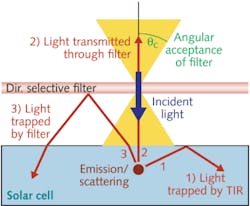METAMATERIALS: Large-area printed 3D negative-index metamaterial is flexible
Three-dimensional negative-index metamaterials (NIMs) have unusual properties that can make possible some very strange optics indeed, including those that produce an inverse Doppler effect, an electromagnetic black hole, and the much-hyped invisibility cloak. In addition, 3D optical NIMs for the visible and near-infrared (NIR) spectral regions could well become the basis for novel and useful lenses, resonators, and other photonic devices. However, these materials, which usually consist of complicated periodic nanostructures made of both dielectrics and metals, have been virtually impossible to scale to sizes large enough to be used for anything but initial experimentation.
This problem is easing, though, with the advent of a printing process that produces large-area 3D multilayer optical NIMs—8.7 × 8.7 cm square, in the largest example so far. Developed by researchers at the University of Illinois at Urbana-Champaign, the US Navy NAVAIR-Naval Air Warfare Center Weapons Division (China Lake, CA), and Sandia National Laboratories (Albuquerque, NM), the process can transfer high-quality metamaterials to a rigid or flexible substrate; these metamaterials exhibit a strongly negative refractive index in the NIR region.
Extremely high-throughput fabrication
First, a polymer mask created through nanoimprint lithography is used as an imprint mold to create the required pattern on a silicon wafer via anisotropic etching. This patterned wafer then serves as a stamp upon which multiple metamaterial layers are coated. Finally, the stamp is used to print the metamaterial structure onto the desired substrate. The imprint mold is durable enough to create many stamps, each of which can be used many times for printing. Because each printing results in an area of greater than 105 × 105 unit cells, the throughput of the technique is very high—on the order of 108 times higher than that for metamaterials produced with focused ion beams (see figure).
An example printed metamaterial has a period of 850 nm with a fishnet design having rib widths of 635 and 225 nm in the x and y directions, respectively. The structure is built up of 11 alternating layers of silver (Ag) and magnesium fluoride (MgF2) with 30 and 50 nm thicknesses, respectively, on top of a sacrificial layer of silicon dioxide for easy release during printing. The structure can be printed on substrates such as polydimethylsiloxane (a type of silicone), or can even be removed from the silicon stamp and left as a free-standing membrane. Although negative-index behavior, which occurs for normal-incidence light, is lost over portions of a floppy free-standing membrane, the researchers say that this flexibility is what makes the structure mechanically robust enough for printing and for real-life uses.
A combination of optical measurements and calculations was used to determine the metamaterial’s optical properties. At a wavelength of 2.4 µm, the real portion of the refractive index [or Re(n)] was about -7, while the figure of merit (FOM) was about 8 at a 1.95 µm wavelength. Both these figures indicate a low optical loss in comparison to a pre-existing 3D NIM with Re(n) of about -1.5 at 1.775 µm and a FOM of about 3 at 1.8 µm.
Both three- and eleven-layer structures were successfully fabricated, with the former an example of a 2D NIM, and the latter thick enough to be a 3D NIM. Even the largest 3D NIM had optical properties that hardly varied when measured at multiple points across the device, showing the high uniformity of the fabrication technique.
Automation would allow very large quantities of this NIM to be made. “A key advance is that we, and others, can begin to explore such applications in a realistic way, due to the easy availability of large-area sheets of this stuff,” says John Rogers, one of the University of Illinois researchers. He notes that the team is working on schemes to extend the range of operation of the 3D NIM into the visible regime.
REFERENCE
1. D. Chanda et al., NatureNanotechnol., 6, 402 (2011), pub. online June 5, 2011; doi:10.1038/nnano.2011.82.
About the Author
John Wallace
Senior Technical Editor (1998-2022)
John Wallace was with Laser Focus World for nearly 25 years, retiring in late June 2022. He obtained a bachelor's degree in mechanical engineering and physics at Rutgers University and a master's in optical engineering at the University of Rochester. Before becoming an editor, John worked as an engineer at RCA, Exxon, Eastman Kodak, and GCA Corporation.

